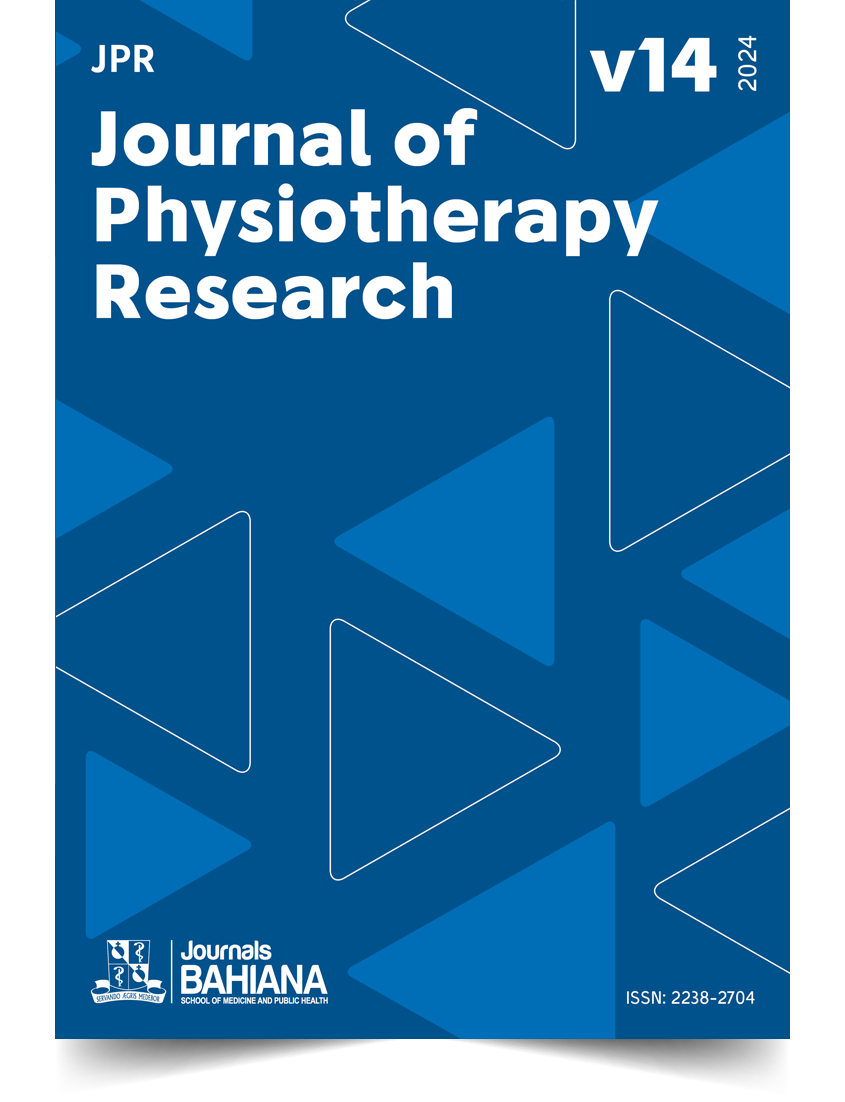Effects of pulsed electromagnetic field and retrowalking in patients with chronic non-specific low back pain: a pilot study
DOI:
https://doi.org/10.17267/2238-2704rpf.2024.e5608Keywords:
Electromagnetic Fields, Low Back Pain, Kinesiophobia, Clinical TrialAbstract
INTRODUCTION: Chronic non-specific low back pain (CNSLBP) is a major worldwide condition that has severe emotional, social, and economic consequences. Management is difficult, requiring the development of new, effective, and safe approaches. OBJECTIVES: This study was conducted to examine the effects of Pulsed Electromagnetic Fields (PEMF) and retrowalking on pain, disability, spinal mobility, hamstring tightness, balance, and kinesiophobia in patients with chronic non-specific low back pain. MATERIALS AND METHODS: Participants (n= 48) with CNSLBP were randomised into four groups; Group A: Conventional group, Group B: PEMF group, Group C: retrowalking group, and Group D: PEMF and retrowalking group. The interventions were given three times per week for six weeks. The outcomes were pain, disability, hamstring tightness, balance, spinal mobility and kinesiophobia, measured at baseline and after 6 weeks. RESULTS: The result suggested a significant improvement in pain, disability, hamstring tightness, kinesiophobia and balance. However, no significant improvement in spinal mobility (flexion and extension ROM) was observed during the sixth week between-group comparison. The maximum improvement was seen in group D followed by group C and group B in comparison to group A. CONCLUSION: It can be concluded that PEMF and retrowalking when given in combination significantly decrease pain, disability, hamstring tightness, kinesiophobia and improve balance patients with chronic non-specific low back pain.
Downloads
References
(1) Fatoye F, Gebrye T, Ryan CG, Useh U, Mbada C. Global and regional estimates of clinical and economic burden of low back pain in high-income countries: a systematic review and meta-analysis. Front Public Health. 2023;11:1098100. https://doi.org/10.3389/fpubh.2023.1098100
(2) Mattiuzzi C, Lippi G, Bovo C. Current epidemiology of low back pain. Journal of Hospital Management and Health Policy. 2020;4. https://doi.org/10.21037/jhmhp-20-17
(3) O'Keeffe M, Ferreira GE, Harris IA, Darlow B, Buchbinder R, Traeger AC, et al. Effect of diagnostic labelling on management intentions for Non‐Specific low back pain: A randomized Scenario‐Based experiment. European Journal of Pain. 2022;26(7):1532-45. https://doi.org/10.1002/ejp.1981
(4) Rahman NAA, Li S, Schmid S, Shaharudin S. Biomechanical factors associated with non-specific low back pain in adults: A systematic review. Physical Therapy in Sport. 2023;59:60-72. https://doi.org/10.1016/j.ptsp.2022.11.011
(5) Joshi S, Singh SK, Vij JS. Effect of Retrowalking, a Non-Pharmacological Treatment on Pain, Disability, Balance and Gait in Knee Osteoarthritis: A Randomized Controlled Trial. Indian Journal of Public Health Research & Development. 2019;10(2):214-219. http://doi.org/10.5958/0976-5506.2019.00288.2
(6) Sharma S, Joshi S. Potential Use of Pulsed Electromagnetic Field in Musculoskeletal Disorders: A Narrative Review. Journal of the Dow University of Health Sciences. 2024;18(1). https://doi.org/10.36570/jduhs.2024.1.1703
(7) Karnati VNP, Reddy SK. Core Stabilization Program and Conventional Exercises in the Patients with Low Back Pain-A Comparative Study. International Journal of Physiotherapy. 2015;2(1):352-60. https://doi.org/10.15621/ijphy/2015/v2i1/60041
(8) Hodges PW, Richardson CA. Altered trunk muscle recruitment in people with low back pain with upper limb movement at different speeds. Archives of physical medicine and rehabilitation. 1999;80(9):1005-12. https://doi.org/10.1016/s0003-9993(99)90052-7
(9) Eldridge SM, Chan CL, Campbell MJ, Bond CM, Hopewell S, Thabane L, et al. CONSORT 2010 statement: extension to randomised pilot and feasibility trials. BMJ. 2016;355. https://doi.org/10.1136/bmj.i5239
(10) Julious SA. Sample size of 12 per group rule of thumb for a pilot study. Pharmaceutical Statistics: The Journal of Applied Statistics in the Pharmaceutical Industry. 2005;4(4):287-91. https://doi.org/10.1002/pst.185
(11) Su DB, Zhao ZX, Yin DC, Ye YJ. Promising application of pulsed electromagnetic fields on tissue repair and regeneration. Prog Biophys Mol Biol. 2024;187:36-50. https://doi.org/10.1016/j.pbiomolbio.2024.01.003
(12) Raza T, Riaz S, Ahmad F, Shehzadi I, Ijaz N, Ali S. Investigating the Effects of Retro Walking on Pain, Physical Function, and Flexibility in Chronic Non-specific Low Back Pain. Iranian Rehabilitation Journal. 2023;21(2):309-18. https://doi.org/10.32598/irj.21.2.1880.1
(13) Whitley CR, Dufek JS. The Effect Of Retro Locomotion On Flexibility Of The Low Back And Hamstrings. Medicine & Science in Sports & Exercise. 2009;41(5):358. http://dx.doi.org/10.1249/01.MSS.0000355640.23833.8b
(14) Ansari S, Raza S, Bhati P. Impact of retrowalking on pain, range of motion, muscle fatigability, and balance in collegiate athletes with chronic mechanical low back pain. Sport Sci Health. 2021;17:307-16. https://doi.org/10.1007/s11332-020-00682-y
(15) Parikh PR, Desai DS. Effectiveness of Forward Walking Versus Retro Walking on Balance, Gait Speed and Lower Body Functional Strength among the Elderly Population-A Comparative Study. International Journal of Health Sciences and Research. 2022;12(4):283-91. https://doi.org/10.52403/ijhsr.20220433
(16) Woby SR, Roach NK, Urmston M, Watson PJ. The relation between cognitive factors and levels of pain and disability in chronic low back pain patients presenting for physiotherapy. European journal of pain. 2007;11(8):869-77. https://doi.org/10.1016/j.ejpain.2007.01.005
(17) Zagyapan R, Iyem C, Kurkcuoglu A, Pelin C, Tekindal MA. The relationship between balance, muscles, and anthropomorphic features in young adults. Anat Res Int. 2012;2012:146063. https://doi.org/10.1155/2012/146063
(18) Endo Y, Sakamoto M. Relationship between lower extremity tightness and star excursion balance test performance in junior high school baseball players. J Phys Ther Sci. 2014;26(5):661-3. https://doi.org/10.1589/jpts.26.661
(19) Fritz JM, George SZ, Delitto A. The role of fear-avoidance beliefs in acute low back pain: relationships with current and future disability and work status. Pain. 2001;94(1):7-15. https://doi.org/10.1016/S0304-3959(01)00333-5
(20) Atya AM. The validity of spinal mobility for prediction of functional disability in male patients with low back pain. Journal of Advanced Research. 2013;4(1):43-9. https://doi.org/10.1016/j.jare.2012.01.002
Downloads
Published
Issue
Section
License
Copyright (c) 2024 Sujata Sharma, Shabnam Joshi

This work is licensed under a Creative Commons Attribution 4.0 International License.
This work is licensed under a Creative Commons Attribution 4.0 International License.



